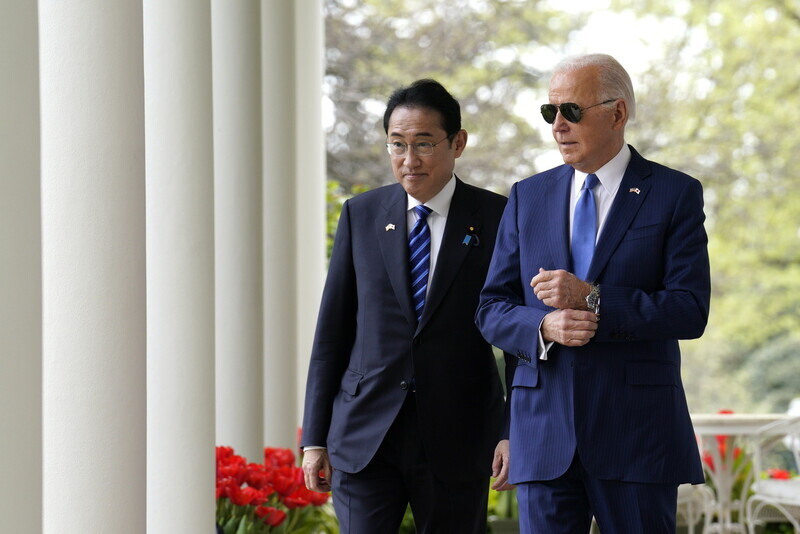hankyoreh
Links to other country sites 다른 나라 사이트 링크
[Correspondent’s column] The US and the end of Japanese pacifism


By Kim So-youn, Tokyo correspondent
US President Joe Biden and Japanese Prime Minister Fumio Kishida held a summit on Wednesday in Washington, DC, where they agreed to enhance defense cooperation, joint weapons development and production, and cooperation between the leadership of US and Japanese forces. The US and Japan are bolstering their alliance to counter China’s progressing military aggression in the South China Sea and East China Sea. Against this backdrop, Japan is expected to radically increase its defense spending. For the first time since World War II, Japan is aggressively rearming itself to become a major military power — and the US is actively encouraging it.
The US and Japan are even considering expanding their joint weapons development and production to include an export operation that would sell to third parties. The Yomiuri Shimbun reported, “With the relaxation of restrictions on exports to third-party countries, joint US-Japan production of defense equipment is expected to increase.”
On March 26, the Japanese cabinet approved a plan to export next-generation fighter jets jointly developed with Italy and the UK to third-party countries, effectively revising its “three principles on the transfer of defense equipment and technology.” The export of jointly developed weapons will create additional revenue that will reduce the cost of development and production. It will also create opportunities for cooperation with other nations. In fact, the trilateral alliance between Australia, the UK and the US (AUKUS) is considering bringing Japan into the fold of their joint weapons development programs.
Japan’s postwar constitution, often referred to as its “pacifist constitution,” banned weapons exports. This restriction has been gradually relaxed since 2014, during the second Shinzo Abe cabinet, allowing Japan to export non-lethal military supplies. Now Tokyo looks to export cutting-edge weaponry that includes fighter jets and missiles as the ruling Liberal Democratic Party discusses measures to approve exports of lethal weaponry.
The agreement to strengthen and improve communications and cooperation between US and Japanese leadership is also an unprecedented move. Japan revised its national security strategy in December 2022 to include the capacity to intercept missile attacks and to preemptively strike regional missile bases in neighboring countries such as China and North Korea. The capacity to strike enemy missile bases requires a high level of integration with the US military at a high level.
The key weapon that Japan would utilize in a strike on enemy missile bases is the US Tomahawk cruise missile. Since the formation of the US-Japan military alliance in 1952, the agreement was that the US would serve as the spear (offense) while Japan would be the shield (defense). Now, it looks as if the two nations will revise their joint military leadership structure to allow both Japan and the US to act as spears.
Since the establishment of Japan’s postwar constitution in 1947, Tokyo has never amended the document. Hard-line prime ministers like Nobusuke Kishi (1896-1987) and Shinzo Abe (1954-2022) have attempted to amend it, but the Japanese public has remained steadfast in preserving the pacifist constitution. The core of the pacifist constitution is Article 9, the “Renunciation of War,” which states that “the Japanese people forever renounce war as a sovereign right of the nation and the threat or use of force as means of settling international disputes.”
“In order to accomplish the aim of the preceding paragraph,” the article continues, “land, sea, and air forces, as well as other war potential, will never be maintained. The right of belligerency of the state will not be recognized.”
While it will likely remain difficult to officially amend Article 9, its efficacy has clearly been waning. The pacifist constitution is now a shell of its former self.
Even as Japan inches closer to the threat of war, the Japanese public remains silent. A recent survey conducted by the Yomiuri Shimbun revealed that 84% of the Japanese public “feels a security threat.” Chinese, North Korean and Russian military aggression feeds a growing anxiety regarding national security among the Japanese public. This inspires Japan to upgrade its military, which in turn escalates tensions throughout East Asia.
My heart is heavy, as this vicious cycle appears nowhere close to stopping.
Please direct questions or comments to [english@hani.co.kr]

Editorial・opinion
![[Column] Season 2 of special prosecutor probe may be coming to Korea soon [Column] Season 2 of special prosecutor probe may be coming to Korea soon](https://flexible.img.hani.co.kr/flexible/normal/500/300/imgdb/original/2024/0426/3317141030699447.jpg) [Column] Season 2 of special prosecutor probe may be coming to Korea soon
[Column] Season 2 of special prosecutor probe may be coming to Korea soon![[Column] Park Geun-hye déjà vu in Yoon Suk-yeol [Column] Park Geun-hye déjà vu in Yoon Suk-yeol](https://flexible.img.hani.co.kr/flexible/normal/500/300/imgdb/original/2024/0424/651713945113788.jpg) [Column] Park Geun-hye déjà vu in Yoon Suk-yeol
[Column] Park Geun-hye déjà vu in Yoon Suk-yeol- [Editorial] New weight of N. Korea’s nuclear threats makes dialogue all the more urgent
- [Guest essay] The real reason Korea’s new right wants to dub Rhee a founding father
- [Column] ‘Choson’: Is it time we start referring to N. Korea in its own terms?
- [Editorial] Japan’s rewriting of history with Korea has gone too far
- [Column] The president’s questionable capacity for dialogue
- [Column] Are chaebol firms just pizza pies for families to divvy up as they please?
- [Column] Has Korea, too, crossed the Rubicon on China?
- [Correspondent’s column] In Japan’s alliance with US, echoes of its past alliances with UK
Most viewed articles
- 1‘We must say no’: Seoul defense chief on Korean, USFK involvement in hypothetical Taiwan crisis
- 2Why Kim Jong-un is scrapping the term ‘Day of the Sun’ and toning down fanfare for predecessors
- 3Two factors that’ll decide if Korea’s economy keeps on its upward trend
- 4BTS says it wants to continue to “speak out against anti-Asian hate”
- 5After election rout, Yoon’s left with 3 choices for dealing with the opposition
- 6Gangnam murderer says he killed “because women have always ignored me”
- 7South Korea officially an aged society just 17 years after becoming aging society
- 8Noting shared ‘values,’ Korea hints at passport-free travel with Japan
- 9Ethnic Koreans in Japan's Utoro village wait for Seoul's help
- 10US citizens send letter demanding punishment of LKP members who deny Gwangju Massacre